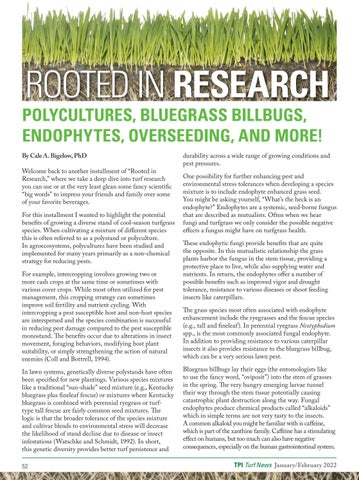ROOTED IN RESEARCH
POLYCULTURES, BLUEGRASS BILLBUGS, ENDOPHYTES, OVERSEEDING, AND MORE! By Cale A. Bigelow, PhD Welcome back to another installment of “Rooted in Research,” where we take a deep dive into turf research you can use or at the very least glean some fancy scientific “big words” to impress your friends and family over some of your favorite beverages. For this installment I wanted to highlight the potential benefits of growing a diverse stand of cool-season turfgrass species. When cultivating a mixture of different species this is often referred to as a polystand or polyculture. In agroecosystems, polycultures have been studied and implemented for many years primarily as a non-chemical strategy for reducing pests. For example, intercropping involves growing two or more cash crops at the same time or sometimes with various cover crops. While most often utilized for pest management, this cropping strategy can sometimes improve soil fertility and nutrient cycling. With intercropping a pest susceptible host and non-host species are interspersed and the species combination is successful in reducing pest damage compared to the pest susceptible monostand. The benefits occur due to alterations in insect movement, foraging behaviors, modifying host plant suitability, or simply strengthening the action of natural enemies (Coll and Bottrell, 1994). In lawn systems, genetically diverse polystands have often been specified for new plantings. Various species mixtures like a traditional “sun-shade” seed mixture (e.g., Kentucky bluegrass plus fineleaf fescue) or mixtures where Kentucky bluegrass is combined with perennial ryegrass or turftype tall fescue are fairly common seed mixtures. The logic is that the broader tolerance of the species mixture and cultivar blends to environmental stress will decrease the likelihood of stand decline due to disease or insect infestations (Watschke and Schmidt, 1992). In short, this genetic diversity provides better turf persistence and 52
durability across a wide range of growing conditions and pest pressures. One possibility for further enhancing pest and environmental stress tolerances when developing a species mixture is to include endophyte enhanced grass seed. You might be asking yourself, “What’s the heck is an endophyte?” Endophytes are a systemic, seed-borne fungus that are described as mutualists. Often when we hear fungi and turfgrass we only consider the possible negative effects a fungus might have on turfgrass health. These endophytic fungi provide benefits that are quite the opposite. In this mutualistic relationship the grass plants harbor the fungus in the stem tissue, providing a protective place to live, while also supplying water and nutrients. In return, the endophytes offer a number of possible benefits such as improved vigor and drought tolerance, resistance to various diseases or shoot feeding insects like caterpillars. The grass species most often associated with endophyte enhancement include the ryegrasses and the fescue species (e.g., tall and fineleaf). In perennial ryegrass Neotyphodium spp., is the most commonly associated fungal endophyte. In addition to providing resistance to various caterpillar insects it also provides resistance to the bluegrass billbug, which can be a very serious lawn pest. Bluegrass billbugs lay their eggs (the entomologists like to use the fancy word, “oviposit”) into the stem of grasses in the spring. The very hungry emerging larvae tunnel their way through the stem tissue potentially causing catastrophic plant destruction along the way. Fungal endophytes produce chemical products called “alkaloids” which in simple terms are not very tasty to the insects. A common alkaloid you might be familiar with is caffeine, which is part of the xanthine family. Caffeine has a stimulating effect on humans, but too much can also have negative consequences, especially on the human gastrointestinal system. TPI Turf News January/February 2022










